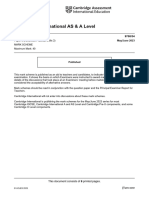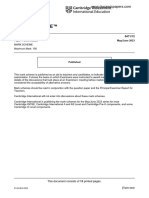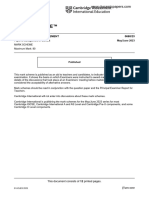9700_s23_ms_31
9700_s23_ms_31
Uploaded by
alashigidi123Copyright:
Available Formats
9700_s23_ms_31
9700_s23_ms_31
Uploaded by
alashigidi123Copyright
Available Formats
Share this document
Did you find this document useful?
Is this content inappropriate?
Copyright:
Available Formats
9700_s23_ms_31
9700_s23_ms_31
Uploaded by
alashigidi123Copyright:
Available Formats
www.dynamicpapers.
com
Cambridge International AS & A Level
BIOLOGY 9700/31
Paper 3 (Advanced Practical Skills 1) May/June 2023
MARK SCHEME
Maximum Mark: 40
Published
This mark scheme is published as an aid to teachers and candidates, to indicate the requirements of the
examination. It shows the basis on which Examiners were instructed to award marks. It does not indicate the
details of the discussions that took place at an Examiners’ meeting before marking began, which would have
considered the acceptability of alternative answers.
Mark schemes should be read in conjunction with the question paper and the Principal Examiner Report for
Teachers.
Cambridge International will not enter into discussions about these mark schemes.
Cambridge International is publishing the mark schemes for the May/June 2023 series for most
Cambridge IGCSE, Cambridge International A and AS Level and Cambridge Pre-U components, and some
Cambridge O Level components.
This document consists of 9 printed pages.
© UCLES 2023 [Turn over
9700/31 Cambridge International AS & A Level – Mark Scheme www.dynamicpapers.com
May/June 2023
PUBLISHED
Generic Marking Principles
These general marking principles must be applied by all examiners when marking candidate answers. They should be applied alongside the
specific content of the mark scheme or generic level descriptors for a question. Each question paper and mark scheme will also comply with these
marking principles.
GENERIC MARKING PRINCIPLE 1:
Marks must be awarded in line with:
the specific content of the mark scheme or the generic level descriptors for the question
the specific skills defined in the mark scheme or in the generic level descriptors for the question
the standard of response required by a candidate as exemplified by the standardisation scripts.
GENERIC MARKING PRINCIPLE 2:
Marks awarded are always whole marks (not half marks, or other fractions).
GENERIC MARKING PRINCIPLE 3:
Marks must be awarded positively:
marks are awarded for correct/valid answers, as defined in the mark scheme. However, credit is given for valid answers which go beyond
the scope of the syllabus and mark scheme, referring to your Team Leader as appropriate
marks are awarded when candidates clearly demonstrate what they know and can do
marks are not deducted for errors
marks are not deducted for omissions
answers should only be judged on the quality of spelling, punctuation and grammar when these features are specifically assessed by the
question as indicated by the mark scheme. The meaning, however, should be unambiguous.
GENERIC MARKING PRINCIPLE 4:
Rules must be applied consistently, e.g. in situations where candidates have not followed instructions or in the application of generic level
descriptors.
© UCLES 2023 Page 2 of 9
9700/31 Cambridge International AS & A Level – Mark Scheme www.dynamicpapers.com
May/June 2023
PUBLISHED
GENERIC MARKING PRINCIPLE 5:
Marks should be awarded using the full range of marks defined in the mark scheme for the question (however; the use of the full mark range may
be limited according to the quality of the candidate responses seen).
GENERIC MARKING PRINCIPLE 6:
Marks awarded are based solely on the requirements as defined in the mark scheme. Marks should not be awarded with grade thresholds or
grade descriptors in mind.
© UCLES 2023 Page 3 of 9
9700/31 Cambridge International AS & A Level – Mark Scheme www.dynamicpapers.com
May/June 2023
PUBLISHED
Science-Specific Marking Principles
1 Examiners should consider the context and scientific use of any keywords when awarding marks. Although keywords may be present, marks
should not be awarded if the keywords are used incorrectly.
2 The examiner should not choose between contradictory statements given in the same question part, and credit should not be awarded for
any correct statement that is contradicted within the same question part. Wrong science that is irrelevant to the question should be ignored.
3 Although spellings do not have to be correct, spellings of syllabus terms must allow for clear and unambiguous separation from other
syllabus terms with which they may be confused (e.g. ethane / ethene, glucagon / glycogen, refraction / reflection).
4 The error carried forward (ecf) principle should be applied, where appropriate. If an incorrect answer is subsequently used in a scientifically
correct way, the candidate should be awarded these subsequent marking points. Further guidance will be included in the mark scheme
where necessary and any exceptions to this general principle will be noted.
5 ‘List rule’ guidance
For questions that require n responses (e.g. State two reasons …):
The response should be read as continuous prose, even when numbered answer spaces are provided.
Any response marked ignore in the mark scheme should not count towards n.
Incorrect responses should not be awarded credit but will still count towards n.
Read the entire response to check for any responses that contradict those that would otherwise be credited. Credit should not be
awarded for any responses that are contradicted within the rest of the response. Where two responses contradict one another, this
should be treated as a single incorrect response.
Non-contradictory responses after the first n responses may be ignored even if they include incorrect science.
© UCLES 2023 Page 4 of 9
9700/31 Cambridge International AS & A Level – Mark Scheme www.dynamicpapers.com
May/June 2023
PUBLISHED
6 Calculation specific guidance
Correct answers to calculations should be given full credit even if there is no working or incorrect working, unless the question states ‘show
your working’.
For questions in which the number of significant figures required is not stated, credit should be awarded for correct answers when rounded
by the examiner to the number of significant figures given in the mark scheme. This may not apply to measured values.
For answers given in standard form (e.g. a 10n) in which the convention of restricting the value of the coefficient (a) to a value between 1
and 10 is not followed, credit may still be awarded if the answer can be converted to the answer given in the mark scheme.
Unless a separate mark is given for a unit, a missing or incorrect unit will normally mean that the final calculation mark is not awarded.
Exceptions to this general principle will be noted in the mark scheme.
7 Guidance for chemical equations
Multiples / fractions of coefficients used in chemical equations are acceptable unless stated otherwise in the mark scheme.
State symbols given in an equation should be ignored unless asked for in the question or stated otherwise in the mark scheme.
© UCLES 2023 Page 5 of 9
9700/31 Cambridge International AS & A Level – Mark Scheme www.dynamicpapers.com
May/June 2023
PUBLISHED
Mark scheme abbreviations:
; separates marking points
/ alternative answers for the same marking point
R reject
A accept
I ignore
AVP any valid point
AW alternative wording (where responses vary more than usual)
ecf error carried forward
underline actual word underlined must be used by candidate (grammatical variants accepted)
max indicates the maximum number of marks that can be given
ora or reverse argument
© UCLES 2023 Page 6 of 9
9700/31 Cambridge International AS & A Level – Mark Scheme www.dynamicpapers.com
May/June 2023
PUBLISHED
Question Answer Marks
1(a)(i) 1 heading for independent variable: pH (before heading for dependent variable) ; 5
2 heading dependent variable: time for beads to rise / seconds and no units in body of table ;
3 two results for each pH ;
4 time taken for pH3 is longer than the time taken for pH7 ;
5 results recorded in whole seconds ;
1(a)(ii) pH ; 1
1(a)(iii) identifies one error e.g. difficult to judge when the bead reaches the top, size of bead varies ; 1
1(a)(iv) records a time for U between that recorded for pH4 and pH7 and seconds ; 1
1(a)(v) correct estimate for U ; 1
1(a)(vi) any two from: 2
1 same pH ;
2 5 different concentrations of hydrogen peroxide ;
3 serial or proportional dilution ;
1(b)(i) 20 mmol dm–3 and 40 mmol dm–3 2
1 lactose concentration increases so more enzyme substrate complexes ;
60 mmol dm-3 and 140 mmol dm–3
2 all active sites are saturated, so maximum rate of reaction is reached ;
1(b)(ii) 1 shows Vmax on graph ; 3
2 shows ½ Vmax on graph ;
3 18 ;
© UCLES 2023 Page 7 of 9
9700/31 Cambridge International AS & A Level – Mark Scheme www.dynamicpapers.com
May/June 2023
PUBLISHED
Question Answer Marks
1(c) 1 x-axis: type of mammal and bars labelled RA, SE, GO, SH and HO 4
and
y-axis: concentration of lactose / mmol dm–3 ;
2 scale on x-axis: even width of bars
and
scale on y-axis: 50 mmol dm–3 to 2 cm and labelled at least every 2 cm ;
3 correct plotting of all five bars ;
4 five separate bars drawn and with horizontal and vertical lines joined precisely ;
Question Answer Marks
2(a)(i) 1 minimum size ; 5
2 correct section of the leaf drawn and no cells drawn ;
3 draws correct shape of the midrib ;
4 draws one large vascular bundle and large layer above it in the midrib ;
5 label line and label to lower epidermis ;
2(a)(ii) 1 minimum size and all lines sharp and continuous and no shading ; 5
2 one large and three small xylem vessel elements and each xylem vessel element touches at least two
other xylem vessel elements ;
3 two lines around each xylem vessel element and three lines where xylem vessel elements touch ;
4 correct shape of xylem vessel elements ;
5 label line and label to the lumen of one xylem vessel element ;
© UCLES 2023 Page 8 of 9
9700/31 Cambridge International AS & A Level – Mark Scheme www.dynamicpapers.com
May/June 2023
PUBLISHED
Question Answer Marks
2(b)(i) only observable differences ; 4
any three from e.g.:
feature Fig. 2.2 J1
trichomes present absent ;
large central cells absent present ;
shape curved straight ;
cuticle thick thin ;
2(b)(ii) any two from: 2
1 trichomes and traps water vapour inside the leaf ;
2 curled leaf and increases humidity to reduce the water potential gradient ;
3 sunken stomata and exposed to the humid atmosphere with a low water potential gradient ;
4 thick cuticle and reduces water loss by transpiration ;
2(c) 1 correct measurement of scale bar and structure X ; 4
2 shows length of scale bar divided by 430 ;
3 shows length of structure X divided by the answer to MP2 ;
4 correct answer and units ;
© UCLES 2023 Page 9 of 9
You might also like
- Erp SimDocument17 pagesErp SimGautam D100% (1)
- 9700_s23_ms_32Document9 pages9700_s23_ms_32alashigidi123No ratings yet
- Cambridge International AS & A Level: Biology 9700/42Document25 pagesCambridge International AS & A Level: Biology 9700/42tefam69477No ratings yet
- Physics 0625-41 O Levels 2023 AP 1Document14 pagesPhysics 0625-41 O Levels 2023 AP 1Zahra RaufNo ratings yet
- Cambridge International AS & A Level: Biology 9700/31Document9 pagesCambridge International AS & A Level: Biology 9700/31kshitizshresthaNo ratings yet
- Cambridge IGCSE™: Physics 0625/42Document12 pagesCambridge IGCSE™: Physics 0625/42ProBro Rock 2No ratings yet
- Cambridge International AS & A Level: Biology 9700/35Document8 pagesCambridge International AS & A Level: Biology 9700/35priscillia.sapuletteNo ratings yet
- Cambridge IGCSE™: Biology 0610/43Document12 pagesCambridge IGCSE™: Biology 0610/43KamskiNo ratings yet
- Cambridge International AS & A Level: Accounting 9706/32Document17 pagesCambridge International AS & A Level: Accounting 9706/32Marcel JonathanNo ratings yet
- Cambridge IGCSE™: Physics 0625/61Document9 pagesCambridge IGCSE™: Physics 0625/61kirstyzulu705No ratings yet
- Cambridge IGCSE™: Biology 0610/62Document10 pagesCambridge IGCSE™: Biology 0610/62ahmedamerpsNo ratings yet
- Cambridge International AS & A Level: Biology 9700/43Document24 pagesCambridge International AS & A Level: Biology 9700/43Naila AkhterNo ratings yet
- Cambridge International AS & A Level: Accounting 9706/31Document19 pagesCambridge International AS & A Level: Accounting 9706/31Marcel JonathanNo ratings yet
- Business (2023) MS KuwanaDocument11 pagesBusiness (2023) MS KuwanaemmanuelkuwanaNo ratings yet
- Cambridge International AS & A Level: Biology 9700/31Document8 pagesCambridge International AS & A Level: Biology 9700/31alashigidi123No ratings yet
- March 2023Document13 pagesMarch 2023sherifamrmorsy2000No ratings yet
- Cambridge International AS & A Level: Biology 9700/34Document8 pagesCambridge International AS & A Level: Biology 9700/34LongNo ratings yet
- Cambridge International AS & A Level: Biology 9700/32Document9 pagesCambridge International AS & A Level: Biology 9700/32LongNo ratings yet
- Cambridge International AS & A Level: Biology 9700/33Document8 pagesCambridge International AS & A Level: Biology 9700/33alashigidi123No ratings yet
- Cambridge International AS & A Level: Physics 9702/21Document14 pagesCambridge International AS & A Level: Physics 9702/21Taha Zia SyedNo ratings yet
- Cambridge IGCSE™: Chemistry 0620/43Document11 pagesCambridge IGCSE™: Chemistry 0620/43azzahrah1266No ratings yet
- Cambridge International AS & A Level: Biology 9700/33Document7 pagesCambridge International AS & A Level: Biology 9700/33alashigidi123No ratings yet
- Cambridge IGCSE™: Physics 0625/33Document13 pagesCambridge IGCSE™: Physics 0625/33Susan GeorgeNo ratings yet
- Nov 2023 V3Document16 pagesNov 2023 V3sherifamrmorsy2000No ratings yet
- Cambridge International AS & A Level: Physics 9702/22Document14 pagesCambridge International AS & A Level: Physics 9702/22Taha Zia SyedNo ratings yet
- Cambridge International AS & A Level: Biology 9700/42Document25 pagesCambridge International AS & A Level: Biology 9700/42mansoormohayuddinNo ratings yet
- Cambridge International AS & A Level: Accounting 9706/42Document15 pagesCambridge International AS & A Level: Accounting 9706/42Hansana PereraNo ratings yet
- Cambridge IGCSE ™: Physics 0625/41Document17 pagesCambridge IGCSE ™: Physics 0625/41Mohamed “MSKOFTCH” HelmyNo ratings yet
- Cambridge IGCSE™: Co-Ordinated Sciences 0654/41Document15 pagesCambridge IGCSE™: Co-Ordinated Sciences 0654/41TimNo ratings yet
- Cambridge IGCSE ™: Physics 0625/42Document15 pagesCambridge IGCSE ™: Physics 0625/42DANIAŁNo ratings yet
- Cambridge IGCSE ™: Biology 0610/61Document9 pagesCambridge IGCSE ™: Biology 0610/61Yara Abd El LatifNo ratings yet
- Cambridge International AS & A Level: Biology 9700/32Document8 pagesCambridge International AS & A Level: Biology 9700/32alashigidi123No ratings yet
- Cambridge IGCSE™: Physics 0625/41Document14 pagesCambridge IGCSE™: Physics 0625/41Susan GeorgeNo ratings yet
- Cambridge International AS & A Level: Biology 9700/22Document22 pagesCambridge International AS & A Level: Biology 9700/22udgfiawgfhweohqfweNo ratings yet
- Cambridge IGCSE™: Chemistry 0620/62Document7 pagesCambridge IGCSE™: Chemistry 0620/62Jahangir KhanNo ratings yet
- Cambridge IGCSE ™: Biology 0610/41Document12 pagesCambridge IGCSE ™: Biology 0610/41Yara Abd El LatifNo ratings yet
- Cambridge IGCSE™: Physics 0625/31Document14 pagesCambridge IGCSE™: Physics 0625/31Susan GeorgeNo ratings yet
- A20LevelsChemistry20 (9701) 20239701 s23 Ms 31 PDFDocument11 pagesA20LevelsChemistry20 (9701) 20239701 s23 Ms 31 PDFtanyabravo21No ratings yet
- Cambridge IGCSE™: Physics 0625/42Document12 pagesCambridge IGCSE™: Physics 0625/42Susan GeorgeNo ratings yet
- Cambridge International AS & A Level: Business 9609/11Document32 pagesCambridge International AS & A Level: Business 9609/11Mumba HopeNo ratings yet
- Cambridge IGCSE™: Travel & Tourism 0471/12Document13 pagesCambridge IGCSE™: Travel & Tourism 0471/12remaselshazly76No ratings yet
- Cambridge International AS & A Level: Business 9609/32Document24 pagesCambridge International AS & A Level: Business 9609/32Fatema NawrinNo ratings yet
- Cambridge IGCSE™: Physics 0625/43Document14 pagesCambridge IGCSE™: Physics 0625/43Susan GeorgeNo ratings yet
- Cambridge International AS & A Level: Business 9609/13Document32 pagesCambridge International AS & A Level: Business 9609/13mrunmayilonkarNo ratings yet
- Cambridge International AS & A Level: Chemistry 9701/42Document19 pagesCambridge International AS & A Level: Chemistry 9701/42PRANAV NARAYANANNo ratings yet
- Cambridge International AS & A Level: AccountingDocument16 pagesCambridge International AS & A Level: AccountingFarrukhsgNo ratings yet
- Cambridge International AS & A Level: Physics 9702/43Document16 pagesCambridge International AS & A Level: Physics 9702/43arnavpro23No ratings yet
- Cambridge IGCSE ™: PhysicsDocument12 pagesCambridge IGCSE ™: Physicswembley1629No ratings yet
- Cambridge International AS & A Level: Business 9609/21Document35 pagesCambridge International AS & A Level: Business 9609/21Maitaishe Gora100% (1)
- Cambridge IGCSE™: Environmental Management 0680/23Document12 pagesCambridge IGCSE™: Environmental Management 0680/23Kerolus Joseph AminNo ratings yet
- Cambridge International AS & A Level: Global Perspectives and Research 9239/03Document9 pagesCambridge International AS & A Level: Global Perspectives and Research 9239/03Harris SusantoNo ratings yet
- Cambridge International AS & A Level: Chemistry 9701/33Document11 pagesCambridge International AS & A Level: Chemistry 9701/33rafeeah nawrinNo ratings yet
- Cambridge IGCSE™: Co-Ordinated Sciences 0654/61Document14 pagesCambridge IGCSE™: Co-Ordinated Sciences 0654/61tkomalshNo ratings yet
- Cambridge International AS & A Level: Business 9609/42Document18 pagesCambridge International AS & A Level: Business 9609/42Harris SusantoNo ratings yet
- Cambridge International AS & A Level: Business 9609/41Document16 pagesCambridge International AS & A Level: Business 9609/41Arnold VasheNo ratings yet
- Cambridge International AS & A Level: Global Perspectives and Research 9239/02Document11 pagesCambridge International AS & A Level: Global Perspectives and Research 9239/02Harris SusantoNo ratings yet
- Cambridge International AS & A Level: Business 9609/12Document32 pagesCambridge International AS & A Level: Business 9609/12Teresa ChiranNo ratings yet
- Junye 2023 (v1) MSDocument12 pagesJunye 2023 (v1) MSdurgesh2715No ratings yet
- Cambridge International AS & A Level: Physics 9702/42Document15 pagesCambridge International AS & A Level: Physics 9702/42ssfa1401No ratings yet
- VMWARE Certified Spring Professional Certification Cased Based Practice Questions - Latest EditionFrom EverandVMWARE Certified Spring Professional Certification Cased Based Practice Questions - Latest EditionNo ratings yet
- AP® Macroeconomics Crash Course, For the 2021 Exam, Book + Online: Get a Higher Score in Less TimeFrom EverandAP® Macroeconomics Crash Course, For the 2021 Exam, Book + Online: Get a Higher Score in Less TimeNo ratings yet
- Music 10 - Q4 - M1W12 CO 1Document39 pagesMusic 10 - Q4 - M1W12 CO 1creguerro.13No ratings yet
- Albrecht Von Urach - The Secret of Japan's Strength PDFDocument11 pagesAlbrecht Von Urach - The Secret of Japan's Strength PDFMihai AdrianNo ratings yet
- SET A. Post Test Part 1Document8 pagesSET A. Post Test Part 1Cath EspanolaNo ratings yet
- Cus 212 EDocument2 pagesCus 212 Evangeliskyriakos8998No ratings yet
- Injection Pump Test SpecificationsDocument3 pagesInjection Pump Test SpecificationsMartin Miguel Gomez SalviNo ratings yet
- Ammonia and Urea Production.Document10 pagesAmmonia and Urea Production.180190105084rabadiyahenilNo ratings yet
- 1st Year Full Book Past Paper MCQS 100 With KeyDocument6 pages1st Year Full Book Past Paper MCQS 100 With KeyAbcdefNo ratings yet
- General Knowledge Questions Practice Test 2Document3 pagesGeneral Knowledge Questions Practice Test 2Arnabi DuttaNo ratings yet
- Forged Documents PDFDocument20 pagesForged Documents PDFNeeraj Shukla100% (1)
- Quanta Physical Sciences Grade 10 CAPS 1st Edition Miemie Pretorius download pdfDocument52 pagesQuanta Physical Sciences Grade 10 CAPS 1st Edition Miemie Pretorius download pdfamuktrusov90100% (1)
- English 8 q3 m3 Literary DevicesDocument7 pagesEnglish 8 q3 m3 Literary DevicesChristian Michael AbiogNo ratings yet
- CU-2020 B. Com. (General) Taxation-II Semester-V Paper-DSE-5.1A QPDocument8 pagesCU-2020 B. Com. (General) Taxation-II Semester-V Paper-DSE-5.1A QPadrijadas487No ratings yet
- 1 Principles of EducationDocument69 pages1 Principles of EducationlottaNo ratings yet
- Chennai Number PDFDocument3 pagesChennai Number PDFkirthika0% (1)
- GitDocument2 pagesGitrajehshsjNo ratings yet
- Java Class PPT1Document147 pagesJava Class PPT1Punith K G100% (1)
- The Virgina Rhea (1983) 1 MLJ 198Document2 pagesThe Virgina Rhea (1983) 1 MLJ 198Fieza ZainulNo ratings yet
- Print Culture and Modern World - HistoryDocument6 pagesPrint Culture and Modern World - HistoryYashaswi GargNo ratings yet
- Safari - 22 Jul 2019 at 4:10 PMDocument1 pageSafari - 22 Jul 2019 at 4:10 PMMary Agnes VillanuevaNo ratings yet
- ImagineFX 208Document100 pagesImagineFX 208JoséLuisCastilloSánchez33% (3)
- Presentation B2B Commerce Webinar 23 6 20Document46 pagesPresentation B2B Commerce Webinar 23 6 20Pragyan Priyal RoutNo ratings yet
- Proposition - The Twelfth NLU Antitrust Law Moot Competition, 2021Document8 pagesProposition - The Twelfth NLU Antitrust Law Moot Competition, 2021Dakshita DubeyNo ratings yet
- Jurnal BullyingDocument13 pagesJurnal BullyingRirin RiswatyNo ratings yet
- Baby Massage Ameliorates Neonatal Jaundice in Full-Term Newborn InfantsDocument6 pagesBaby Massage Ameliorates Neonatal Jaundice in Full-Term Newborn Infantsgladeva yugi antariNo ratings yet
- Nteu Handbook For Casual and Sessional Academic Staff at Deakin UniversityDocument25 pagesNteu Handbook For Casual and Sessional Academic Staff at Deakin Universityrory_dufficyNo ratings yet
- Cause-Effect Lesson Plan ReadDocument12 pagesCause-Effect Lesson Plan Readapi-241278585100% (1)
- Chandan SahooDocument2 pagesChandan SahoosaranNo ratings yet
- Sujet Dissertation Telephone PortableDocument4 pagesSujet Dissertation Telephone PortableHelpWritingPapersSalem100% (1)
- EMERGENCY MEDICINE For NMSCDocument49 pagesEMERGENCY MEDICINE For NMSCVictor VeraNo ratings yet

























































































